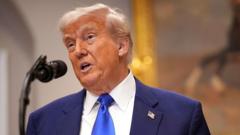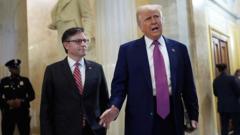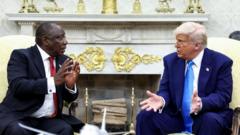The tariffs imposed by President Trump are calculated using a formula derived from the trade deficit with each country, but experts warn that their broader economic impact may not align with the intended outcomes.
Unpacking the Calculations Behind Trump's Heavy Tariffs

Unpacking the Calculations Behind Trump's Heavy Tariffs
An analysis reveals the methodology and implications behind the tariffs imposed by President Donald Trump on imported goods.
In a significant shift in US trade policy, President Donald Trump has enacted a 10% tariff on imports from numerous countries, applying higher rates for those deemed as "worst offenders." The approach and calculations used to determine these tariffs have drawn considerable scrutiny.
Initially, many assumed that these tariffs stemmed from a combination of existing tariffs and various trade barriers. However, the White House later released a detailed formula designed to guide the calculations. This formula simplifies to a fairly straightforward mathematical operation: one takes the trade deficit the US has with a specific nation, divides it by the total imports from that country, then divides the result by two.
A trade deficit occurs when a country imports more goods than it exports. For instance, the US has a $295 billion goods deficit with China, while its total imports from China reach $440 billion. This leads to a calculated tariff of 34% for China after applying the aforementioned formula. When examining the EU, the formula results in a 20% tariff.
Critics of the tariffs argue that they lack reciprocity, which would imply that the tariffs are grounded in the rates other nations apply to the US. Instead, the White House's methodology is focused on eliminating the US's goods trade deficits. Notably, the tariffs have also affected countries like the UK, with which the US does not have a trade deficit, yet still sees a 10% tariff.
Trump's rationale for implementing these tariffs is rooted in the belief that the US is being treated unfairly in global trade, losing jobs and manufacturing opportunities to countries that impose non-tariff barriers while flooding the US market with low-cost goods.
However, economists express skepticism about the effectiveness of the tariffs in achieving their intended goals. While they might reduce trade deficits with specific nations, the overall US trade deficit with the rest of the world is unlikely to diminish significantly. This assertion comes from the understanding that American economic behavior—marked by greater spending and investment than earnings—leads to an overall trade deficit that tariffs alone cannot rectify.
Experts like Professor Jonathan Portes from King's College, London, underscore that the trade deficit cannot be merely attributed to tariffs and regulatory barriers. Legitimate trade deficits often arise from fundamental differences in production capabilities across countries. Thomas Sampson of the London School of Economics contends that the formula employed is a "reverse-engineered" method to justify tariffs on nations with which the US has deficits, lacking any solid economic reasoning and potentially inflicting harm across the global economy.





















